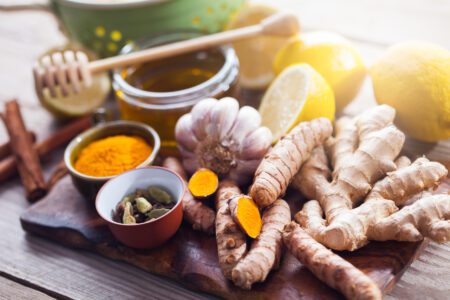Visiting more than 2 million flowers to produce a single pound of honey, bees are some of the hardest workers on our planet—and quite possibly nature’s best cosmetologists. These wondrous winged creatures pollinate about one-sixth of the world’s flowering plant species and about 400 agricultural plants, and from their hard work springs forth a plethora of valuable materials. For centuries, humans have sought the hive to reap these versatile ingredients, many of which are excellent for body care and can be found in countless cosmetic products, from soaps to sunscreens. Relish the fruits of the hive by buying beauty products enriched with bee-produced ingredients or by making some of your own. (Keep in mind that if you’re allergic to bee stings or bee products such as honey, you could also have a reaction to other products listed here, such as propolis.)
Try our Honey Coconut Body Wash Recipe and Homemade Lip Balm Recipe for ways to use honey in your beauty routine.
Gifts from the Hive
Hydrating Honey: Used in everything from cooking to body-care products, honey is probably the most coveted treasure from the hive. Rich in enzymes and trace minerals, honey is produced by bees from the wide array of nectar they collect, resulting in more than 300 types, all varying in color and flavor. Eating a spoonful of this natural antibiotic can help soothe sore throats, and applying a dollop onto a wound may help treat the skin. In beauty products, this natural humectant can hydrate skin by attracting and retaining moisture. Apply raw, unpasteurized honey to your face to smooth and tighten skin, then rinse after 20 minutes or so. (Combine with your favorite facial oil such as sweet almond or coconut to make the mixture more spreadable.) Honey can also help exfoliate skin thanks to its gluconic acid, a mild alpha-hydroxy acid. Mix 2 parts honey with 1 part baking soda to make a gentle exfoliant, and apply to your face, letting it sit for 5 to 10 minutes to loosen dead skin cells and refine pores. Because it’s antibacterial, honey can also make a great acne treatment. Dab a bit of honey onto a blemish to reduce its size.
Softening Beeswax: The waxy material produced by worker bees to build honeycombs, beeswax is an excellent softening agent. Often used to make candles, furniture polish and art, beeswax is also highly sought after for its cosmetic uses. Because of its ability to solidify emulsified substances, beeswax is a great emollient in products such as ointments, creams, sunscreens and lip balms. Rich in vitamin A, it seals in moisture, protects skin and naturally conditions. Apply a beeswax-enriched salve to soften rough patches of skin such as elbows, heels, cuticles or lips.
Healing Propolis: Bees combine beeswax with propolis—a resinous substance bees collect from tree buds—to repair, reinforce and sterilize hives. Research shows that propolis taken from a beehive may fight off infections caused by bacteria and viruses such as cold sores, canker sores and sore throats. Enjoy body-care products made with this natural antiseptic to eliminate unwanted bacteria. It is especially wonderful in soap, facial cleansers and shampoo. Thanks to its promising anti-inflammatory and antibacterial properties, propolis may also help repair skin damage such as scars and rashes.
The Problem with Royal Jelly
Loaded with amino acids, B vitamins and trace minerals, royal jelly is the milky substance that can turn an ordinary bee into a queen bee. It is fed to all larvae for the first three days of their lives, but only a few bees are chosen to continue being fed the jelly. Those queen bees grow 50 percent larger and live about four years longer than the other female bees. Cosmetic companies harvest this exotic substance for a different use, as some believe it may naturally support skin regeneration and rejuvenation.
Unfortunately, harvesting royal jelly can cause undue stress to a beehive. “The first step to harvesting royal jelly is removing the colony’s queen, which stresses them out because they need a queen to survive. As such, bees go into overdrive to produce a new queen,” says Dawn Combs, owner of Mockingbird Meadows. Although few dispute the benefits of royal jelly—both inside and out—we don’t advise using products enriched with this product, as the harvesting of royal jelly may weaken bees left behind in a hive, and may even contribute to the death of a colony.
Bee Mindful
Pesticides, climate change and colony collapse disorder all hamper bees’ ability to thrive. Only buy products from companies that are conscientious about where and how they source their bee-produced ingredients. This way, your purchasing choices encourage the health and growth of sustainable beekeeping operations. Plus, the health benefits of these products are largely dependent on quality. Visit Local Harvest to search for bee products by city or ZIP code.
What is Manuka Honey?
Manuka honey, a honey produced in New Zealand by bees that pollinate the native manuka shrub, has become increasingly popular in body-care products. This striking honey can contain a higher concentration of a special enzyme, methylglyoxal, which makes it even more capable of fighting infection.
Using this extra-potent honey may help treat blemishes, reduce redness and treat similar skin woes. To determine the potency of your manuka honey, look for a label that specifies its Unique Manuka Factor (UMF) rating. A rating of 10 UMF or higher is considered therapeutic.














